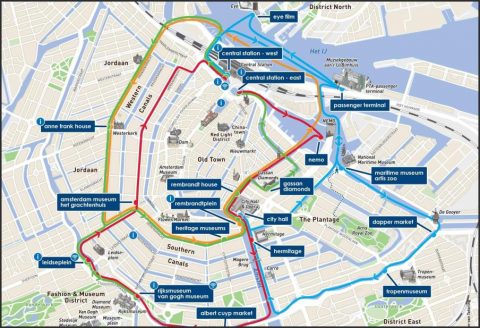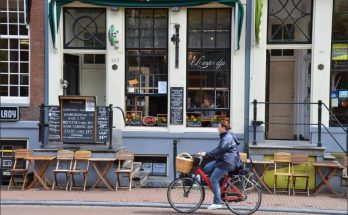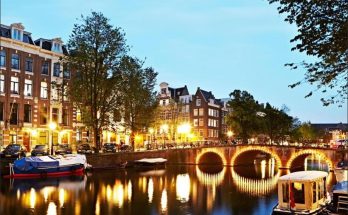The city of Amsterdam is an inverted forest. Its pine trees do not rise from the ground, they bore into it, crown downward. The terrain is so soggy that each house must be built on a solid foundation of piles driven into the mud. The Hollander has a strange name for these subterranean trees; he calls them juffers, young ladies. I wonder why. A compliment to the erect build of Dutch girls may be implied. However that may be, the Hollander, in calling a pole a lady, is less offensive to the fair sex than the German who calls his womenfolk female timber, frauenzimmer. That is inverting the comparison into a downright insult.
Since every house in Amsterdam rests on piles, it is clear that the entire underground city is a dense timber forest. But above ground it is a mass of brick and stone, with spare fringes of foliage along its canals and, here and there, dots of green parks. Where the city ends, the flat country begins, deep-lying polders with a crisscross pattern of ditches lined with dwarfish pollard willows that do not obstruct the endless vista of pasture. There are no woods in the immediate neighborhood of Amsterdam to lure the poor away from the crowded city. The well-to-do have the means to spend their weekends and vacations in Utrecht or Gelderland, or farther away in Switzerland or Germany. But those who can afford no more than a tram ride for an outing must find the pleasures and the benefits of rural life vicariously in the dusty city parks.
Since the larger part of the city’s population cannot be brought to the distant woods, the municipal government has decided to bring the woods to the city. Amsterdam, built on a forest, will in the next few years be belted by a forest. A thousand men are employed in planting trees on the very outskirts of Amsterdam. Rather than have them come to the City Hall each week for their dole, the authorities will pay them for making the city a healthier and pleasanter place to live in for their fellow citizens and themselves.
The plans for this huge enterprise have been made by a committee of experts on forestry, landscape gardening, and botany. But the authorities count chiefly on the assistance of Nature, whose genius for landscape architecture will be given free rein after human adepts have done the planting. The pools and lakes near the city will not be drained but will be left intact for the recreation of anglers and lovers of aquatic sports, who will find there even greater beauty when these favorite haunts mirror sheltering girdles of foliage.
The botanists and landscape architects are hunting all over the world for trees for the new Amsterdam forest. The Far East, Siberia, the Caucasus, and the North American continent will all contribute saplings to the polder landscape. A seventeenth-century poet pitied the worry-sick merchants on the Exchange, who with all their wealth lacked oak in Amsterdam. Twenty years from now the poorest slum dweller will be able to go picnicking of a summer Sunday in the shade of oak or beech or maple or whatever forest growth his fancy prefers.
A crowded city built, as Amsterdam is, among swamps and intersected by a network of stagnant canals that are the receptacles of garbage and sewage would seem to be a breeding place of contagion and disease. This has always presented grave problems to the authorities responsible for the city’s sanitation. An Amsterdam physician of the early nineteenth century found the matter sufficiently interesting to devote to it a book in four volumes, to which he gave the curious title of Medical Topography of Amsterdam.
The author, C. J. Nieuwenhuys , was a radical among his colleagues, a forwardlooking practitioner with advanced ideas about hygiene, physical culture, nursing, medical legislation, and many other related subjects. His book dealt with the Amsterdam climate and its effects upon the people’s physique, with the city’s water supply, the municipal inspection of foodstuffs, the control of infectious diseases, the training of physicians and surgeons, of dentists and midwives, with infant mortality, population statistics, hospital care, prison conditions–in a word, it might well be called a sociological survey of early nineteenth-century Amsterdam. But the word Sociology had not yet been invented in the good doctor’s lifetime, and Medical Topography was the best he could think of. And it must be admitted that his best is very good.
When he began to compile the data for his survey, Amsterdam and the rest of Holland were passing through a depression that was much more serious, probably, than the one from which the city is slowly recovering at present. The Napoleonic wars, in which the country had become involved, had left in their wake a general stagnation of trade. Amsterdam’s commerce was at its lowest ebb, unemployment caused much suffering among the lower classes, and emergency relief drained the resources of the well-to-do. Yet no one seemed to care, says Dr. Nieuwenhuys.
He noticed with pained surprise that public places of amusement were always crowded, that the collapse of business and loss of capital were borne with indifference, and that petitions in bankruptcy were filed by the insolvent with brazen disregard for personal reputation. People seemed to spend more since they possessed less. Divorces increased and marriages decreased in number. The young people, unable to marry on account of the critical economic conditions, disregarded legal conventions, and the number of illegitimate births rose, consequently, to an alarming height.
According to the doctor’s statistics, one-fifth of all the children born in the period from 1812 to 1815 were born out of wedlock. Daughters of good families visited dance halls of ill repute, where they mingled with the better class of hetaerae frequenting those places. In a population of about 220,000,more than 800 of these women were known to the police. Soliciting by streetwalkers was an open scandal. Venereal diseases were common, and the author’s professional experience had led him to believe that there were few men in Amsterdam who, once at least, had not been infected by gonorrhea. In short, our outspoken doctor paints a picture of the city’s public morals such as the literature of the period does not reveal. It is instructive to read such a matter-of-fact account of actual conditions of a past age. It makes one suspect that the general breakdown of self-restraint which the moralists of our day deplore is not a sign of our depraved modernism but the recurrence of a phenomenon that comes and goes with wave-like periodicity.
An even more interesting departure from the style of the recent past may be seen in Amsterdam West. Here each block represents the homogeneous work of one architect; it is not a dull square of exactly similar houses, but each house in it forms an integral part of the whole, the entire block, not the house, being the unit. No gingerbread decorations spoil the severe simplicity of these façades.
The sense of beauty which they evoke is created by the contrast of straight lines and curves, by the right proportion of window space to wall space, by the color of the brick, and by the consistent use of that material in every detail. Thirty years ago the class of people inhabiting this modern section of the city was forced to live in sinister streets where there was nothing beautiful to cheer their existence. May we not believe that the new generation growing up in these bright, artistic dwellings will show the wholesome effect of that environment in greater vitality and love of life than their parents possessed?




